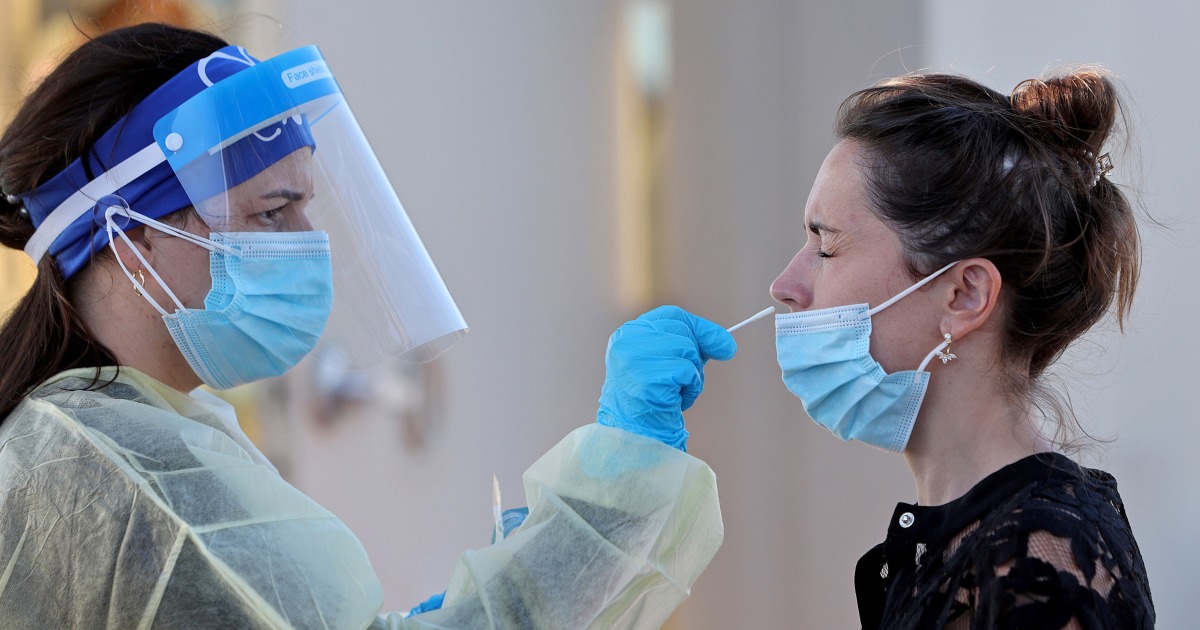
Covid hospitalizations and deaths are each up around 21% in the U.S. since last week, though they remain historically low compared to the same time of year in past summers.
The uptick coincides with the rise of the EG.5 variant, which some health experts nicknamed “Eris” on social media. EG.5 now represents more than 20% of Covid cases in the U.S.
Scientists are also paying attention to a new variant, BA.2.86, that carries a large number of mutations — meaning it looks significantly different from the original version of Omicron and the previously dominant strain targeted by the upcoming Covid booster shots this fall. Only nine cases have been detected in the U.S. thus far.
Guidelines from the Centers for Disease Control and Prevention about masking, testing and isolation have changed slightly since last summer. Here’s what the agency recommends.
When to wear a mask
- The CDC recommends masking based on the level of Covid hospital admissions in your county. You can check your local risk level on the CDC’s online map. The agency currently does not suggest masks for the majority of U.S., but masks are always recommended in indoor public transportation settings. Immunocompromised people and those in their households should wear masks if they live in an area with a medium risk level, which applies to 85 counties right now.
When to test
- Get tested immediately if you have symptoms. If you’re not symptomatic, wait five full days after you were exposed to someone who tested positive (the date of your exposure is considered day zero).
- Consider testing before being around someone with a high risk of severe Covid, especially if your area has a medium or high risk level based on the CDC’s metrics.
If you’ve been exposed to someone who tested positive
- Wear a mask around others, regardless of your vaccination status.
- If symptoms appear, get a test as soon as possible. If you are symptom-free, take a test after five full days.
- The Food and Drug Administration recommends that people with a known exposure who test negative take a second test 48 hours later. (Even if you don’t have a known exposure, the CDC notes that multiple negative tests can increase confidence in the result.)
- If you previously tested positive for Covid within 30 days or less of your exposure, you do not need to test unless you develop symptoms.
- Those who tested positive between 31 and 90 days before their exposure should take a rapid test — not a PCR test — regardless of whether they have symptoms. (PCR tests may stay positive for up to 90 days.)
If you have Covid symptoms
- Isolate until you’re able to get tested. If the test is negative, you can end your isolation, though the FDA recommends taking a second test 48 hours after the first. The CDC’s isolation and exposure calculator can help you decide what action is appropriate.
If you test positive
- Isolate for at least five days after your positive test. Further details about when to leave isolation can be found below.
- Wear a high-quality mask around others through day 10 unless you test negative on two rapid tests administered 48 hours apart. If you continue to test positive beyond day 10, the CDC recommends you continue masking.
- Avoid being around people who are at high risk of severe Covid until at least day 11.
While isolating with a Covid infection
- If you live with others, try to stay in a separate room and use a separate bathroom. Wear a mask around anyone else in the household, wash your hands often, clean surfaces regularly and avoid sharing items like utensils or towels. Open windows and turn on fans to improve airflow. Consider filtering the air in your home, either via your HVAC system or by using a portable air cleaner. A CDC tool can help you figure out how to adjust ventilation settings.
- Stay hydrated and rest. You can take over-the-counter medications, such as Tylenol, to relieve symptoms like fever or muscle aches.
- People at high risk of severe disease should seek treatment right away. The CDC’s locator can help you find Test to Treat sites — which offer tests, medical visits and medications at once — as well as places to fill a prescription. The National Institutes of Health prefers the antiviral pill Paxlovid to treat mild to moderate Covid, although Test to Treat sites also offer Lagevrio, another FDA-authorized pill. Either must be taken within the first five days of symptoms.
- Go to the hospital if you develop severe symptoms, including trouble breathing, persistent pain or pressure in the chest, or pale, gray or blue skin, lips or nail beds.
When to leave isolation
- You can end isolation five full days after your first positive test if you have no symptoms or if your symptoms are clearing up and you are fever-free for 24 hours without taking medication. (If you were asymptomatic, consider the day you were tested to be day zero. If you had symptoms, day zero is the day your symptoms started.) Prolonged loss of taste or smell should not prevent you from ending isolation, since those symptoms can last weeks or months.
- If you still have a fever or your symptoms have not improved after five days, keep isolating until they improve.
- If you continue to test positive beyond day 10, you should continue to wear a mask until you have two sequential negative tests taken at least 48 hours apart.
- Isolate through day 10 if you had moderate illness symptoms such as shortness of breath. People who were hospitalized should consult their doctor before ending isolation.
- If your symptoms recur or worsen after you end isolation, restart your isolation at day zero.






